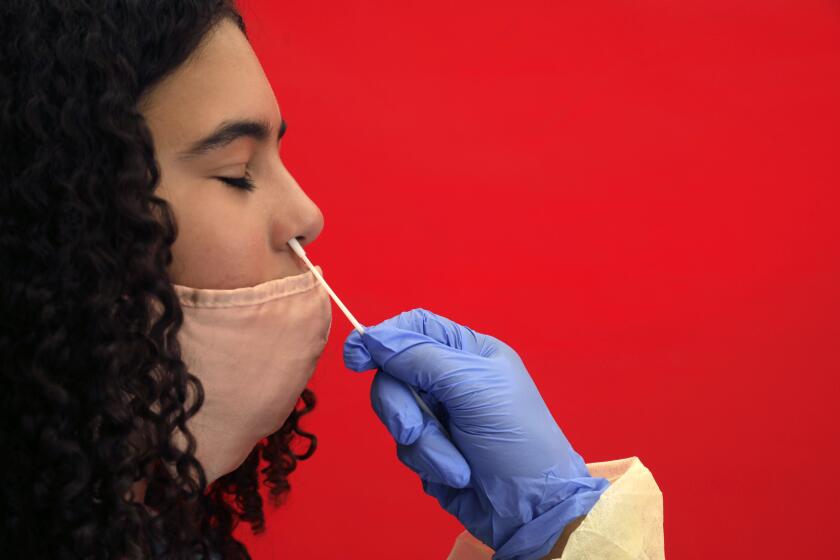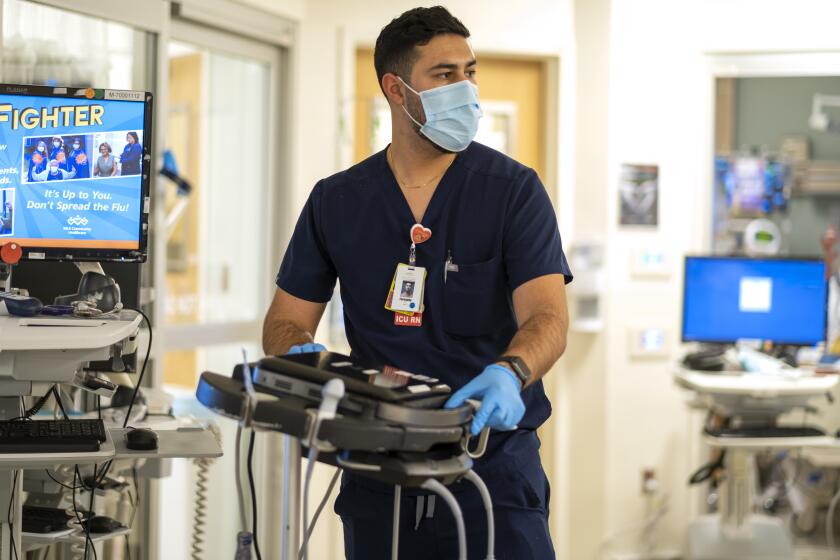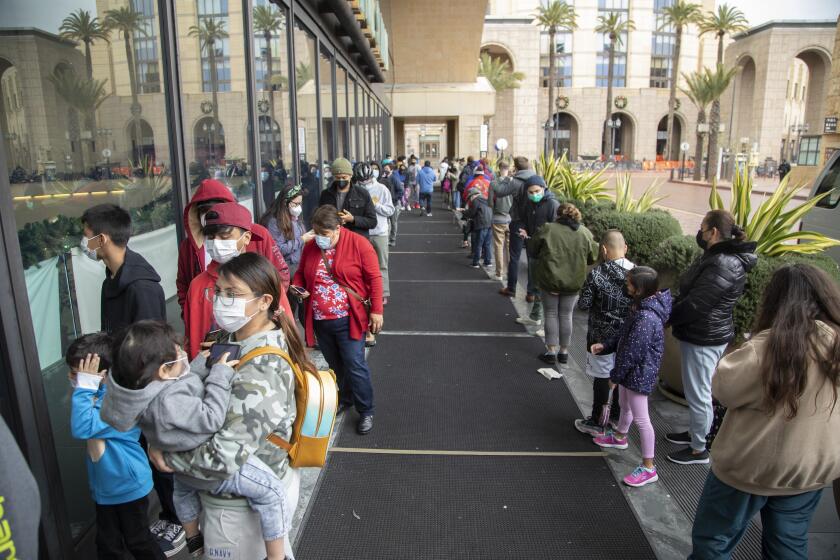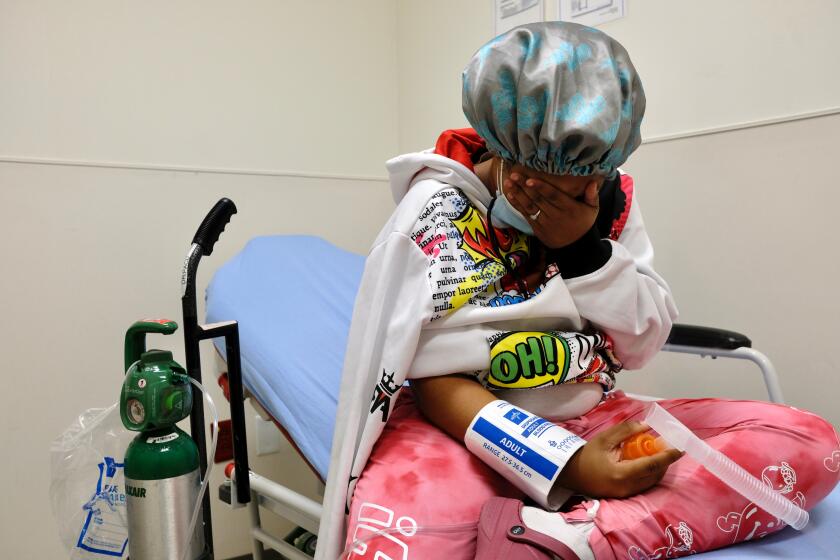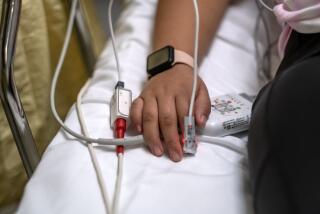Hospitals see big jumps in COVID-19 patients, but this surge is different from last winter
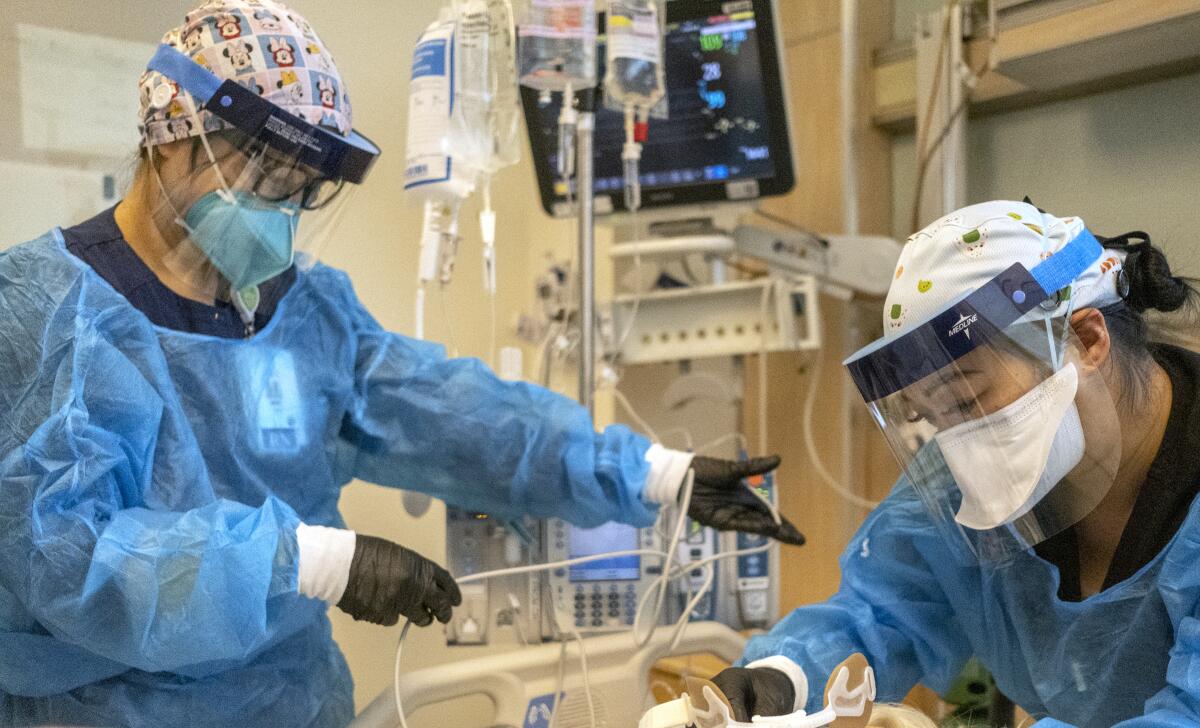
- Share via
The number of coronavirus-positive patients has spiked dramatically across Southern California since Christmas — but some health officials are noting important differences in how the latest surge is playing out in hospitals compared with last winter’s devastating wave.
In Los Angeles, Orange and Ventura counties, the coronavirus-positive patient count has more than doubled in the last nine days. And in L.A. and San Bernardino counties, the daily hospital census has surpassed the peak seen during last summer’s spike.
Some officials remain concerned that hospitals could still face challenges as the highly contagious Omicron variant infects people at what experts are calling an unprecedented rate. But there are signs that the crunch at a number of Southern California’s hospitals may not be as severe as last year, before vaccines were widely available.
Roughly two-thirds of patients who have tested positive at hospitals run by the L.A. County Department of Health Services were admitted for something other than the coronavirus, according to Health Services Director Dr. Christina Ghaly.
That is starkly different from what the county’s public hospitals saw in earlier surges, when most coronavirus-positive patients were hospitalized because they had been sickened by the virus, Ghaly said.
This time around, many “may have not known they were COVID-positive ... but they’re in the hospital for something else,” Ghaly said.
Schools are reopening this week and next with families and employees nervous about health risks from the Omicron surge.
During last winter’s surge, more than 80% of COVID-19 patients were in the hospital because they were experiencing severe illness associated with the disease, according to the Department of Health Services.
“The difference we are seeing this year is largely due to the fact that we have a higher number of individuals who have been vaccinated and boosted,” department officials wrote in a statement to The Times. “With the Omicron variant being highly transmissible, we can’t emphasize enough the importance of having everyone get vaccinated and boosted as soon as they are eligible.”
It’s unclear whether this same trend is playing out statewide. The California Department of Public Health did not immediately respond Monday when asked how many coronavirus-positive patients have been hospitalized directly because of COVID-19 compared with those found to have an ancillary infection upon admission.
But if the current trend holds, Southern California may avoid some of the worse-case hospitalization scenarios envisioned weeks ago.
Dr. Robert Wachter, chair of the UC San Francisco Department of Medicine, held out cautious hope that a surge in coronavirus patients at his institution’s hospitals were stabilizing.
“Still too soon to be sure and, to me, an argument to be more careful, but it’s hopeful,” Wachter wrote on Twitter.
“Omicron,” he added, “may be hitting a big immunity wall” in San Francisco.
That’s not to say there aren’t risks to health and public safety due to soaring coronavirus infections, however.
In L.A. County, officials said they’ve “begun to see delays in ambulance response to 911 calls due to several factors, including a decrease in staff that are unable to report to work due to COVID-related illness and ambulances experiencing extended waiting times to offload patients at hospitals.”
According to the L.A. County Department of Health Services: “People should reach out to their physicians for suggestions to treat mild COVID symptoms. Do not seek COVID testing at emergency departments but at established sites. We urge all L.A. County residents to do their part in helping stop the spread of COVID-19 during this latest surge.”
Every infected person in L.A. County is on average transmitting the virus to two other people, according to estimates from California’s COVID-19 computer models.
On Sunday, 1,994 coronavirus-positive patients were hospitalized in L.A. County — up 121% from the tally seen on Christmas Day.
L.A. County surpassed its summertime COVID-19 hospitalization peak on New Year’s Day, when 1,792 patients with coronavirus infections were in its hospitals. During the summertime Delta surge, the patient count in the nation’s most populous county peaked at 1,790 on Aug. 17, state data show.
However, the number of seriously ill patients remains well shy of last summer. On Sunday, 278 COVID-19 patients were in intensive care units countywide — about 40% below the August peak.
The latest totals also are a far cry from last winter, when more than 8,000 COVID-19 patients were hospitalized countywide on the worst days, and ICUs were at times inundated with more than 1,700.
Southern California has the worst per capita COVID-19 hospitalization rate in the state. Regionwide, for every 100,000 residents, 21 people are hospitalized with a coronavirus infection. Experts have said it’s a concern when that rate is 5 or worse.
The comparable rates are 17 in the Greater Sacramento area, 15 in the San Joaquin Valley, and 10 in the San Francisco Bay Area and rural Northern California.
Within Southern California, the Inland Empire has the worst rates, with San Bernardino County’s at 31 and Riverside County’s at 25. L.A. and San Diego counties have a rate of 20; Ventura County, 18; and Orange County, 17.
Like L.A., San Bernardino County has already surpassed its summertime hospitalization peak. As of Sunday, there were 655 people with coronavirus infections in its hospitals, 113% of the summer peak of 580 hospitalizations.
San Diego and Ventura counties have reached 98% of the number of coronavirus-positive patients seen at the peak of their summer surges. Orange County, at 92%, and Riverside County, at 88%, are approaching theirs as well.
Roughly 87% of current hospitalized patients are unvaccinated in Orange County, figures show.
The winter spread of coronavirus cases is worsening. Here’s the latest advice on protecting yourself and those around you.
Given the high level of local transmission, Ventura County officials announced the region would close its buildings to the public as a precaution for three weeks starting Wednesday. Services will still be offered online and by appointment.
“More people are infectious and spreading the virus indoors,” Ventura Public Health Officer Dr. Robert Levin said in a statement. “Taking these steps — limiting close contacts, wearing a mask indoors to prevent getting infected and infecting others, isolating when symptomatic, testing and getting vaccinated — can reduce the likelihood of severe COVID affecting you, your family and community.”
Starting Monday, Newport Beach also temporarily closed its City Hall and community centers. In a statement, officials said that “all city services will continue, although some will be conducted only through virtual and drop-off” methods and that they anticipate the new protocols will be in place through mid-January.
Experts say everyone should be wearing a mask, and many recommend vaccine verification requirements. But even with both of those, there are risks.
Though the statewide patient count remains below the height of last summer’s surge, it too is swelling rapidly. There were 6,789 coronavirus-positive patients hospitalized throughout California on Sunday, an 81% increase since Christmas.
Health officials have long cautioned that even if Omicron infections are milder than Delta ones, significant spikes will invariably fuel a rise in COVID-19 hospitalizations.
How severe that proves to be, however, remains to be seen. So far, COVID-19 hospitalizations have not risen as fast as coronavirus cases — perhaps a result of Omicron’s lower severity, on average, to many people.
It’s also possible that vaccinations can partly explain why there’s a lower rate of hospitalization. L.A. County Public Health Director Barbara Ferrer last month estimated that while 15% to 20% of coronavirus cases required hospitalization during the surges of 2020 and last winter, only 5% to 6% of cases required hospitalization during the summer Delta surge, which “really reflects the power of those vaccines.”
It’s too soon to say what that percentage will be for the current surge.
“Because some people may not be hospitalized right away after testing positive for COVID-19, increases in hospitalizations generally lag behind increases in cases. As a result, it is too soon to say whether there will be a change in the percentage of cases hospitalized associated with the recent increase in cases,” the state Department of Public Health said in a statement.
New daily cases are doubling every two days in L.A. County, with over 70% in adults under 50. Hospitalizations remain lower than in previous surges.
Still, the number of coronavirus cases has raised alarms.
L.A. County recorded 23,553 new cases Saturday and 21,200 more Sunday, far above last winter’s peak average of 16,000 cases a day. And officials said those numbers are likely undercounts because of lags in weekend reporting.
According to estimates from California’s COVID-19 computer models published Monday morning, every infected person in L.A. County is on average transmitting the virus to two other people — greater than at any point since the early months of the pandemic.
“We hope that by working together to implement essential public health safety measures, we can stay safe, protect those we love and keep our schools and businesses open,” Ferrer said in a statement Sunday. “During this surge, given the spread of a more infectious strain of the virus, lapses can lead to explosive transmission.”
Los Angeles County reported another alarming surge in coronavirus cases Friday, prompting health officials to urge residents to curtain large group celebrations over the New Year’s holiday.
Officials said the latest spike in cases can be attributed both to the Omicron variant, which is estimated to be two to four times as transmissible as Delta, and increased travel and large gatherings over the recent holiday season.
The ultra-contagious nature of Omicron, officials say, heightens the urgency for residents to take steps to protect themselves. Those include wearing masks while in indoor public settings, avoiding crowded situations and — most importantly — getting vaccinated and boosted when eligible.
To date, about 75% of all Californians have received at least one COVID-19 vaccine dose, and 67.5% are considered fully vaccinated. However, that still leaves millions who have yet to roll up their sleeves, including all children under the age of 5, who are not yet eligible.
“We all need to do our part to really protect 2022; it’s already not looking so great for the first couple of months,” said Dr. Regina Chinsio-Kwong, an Orange County deputy health officer. “But the reassuring part of all this is we have known, basic preventive measures that we can take for ourselves and our families.”
More to Read
Sign up for Essential California
The most important California stories and recommendations in your inbox every morning.
You may occasionally receive promotional content from the Los Angeles Times.
